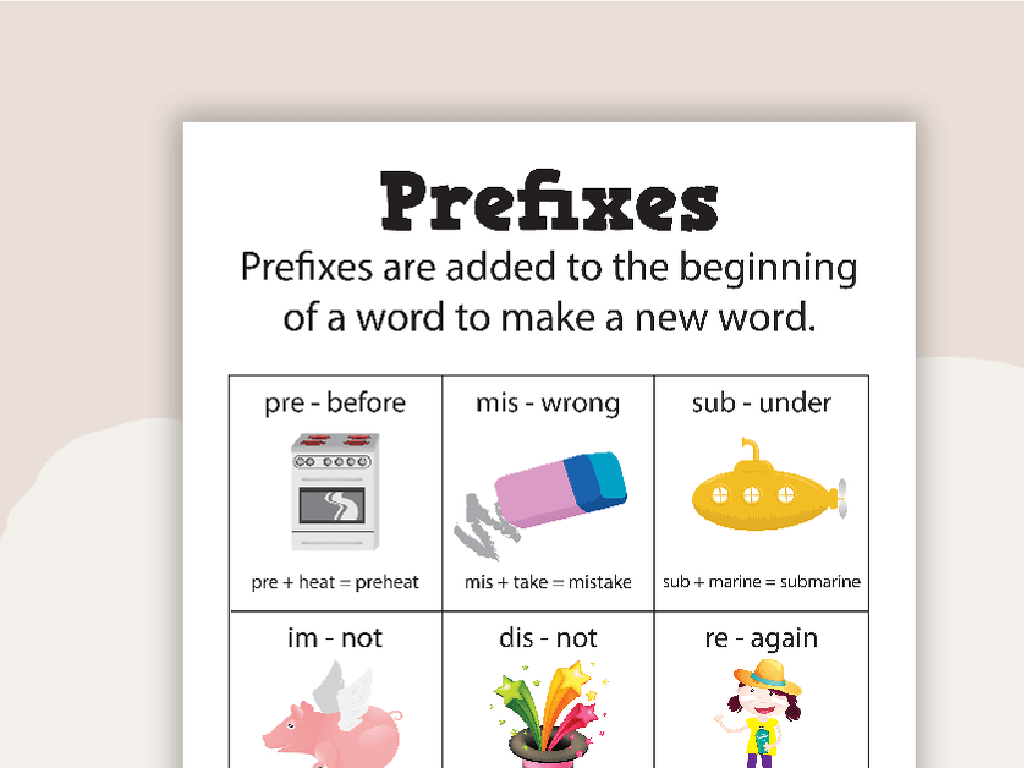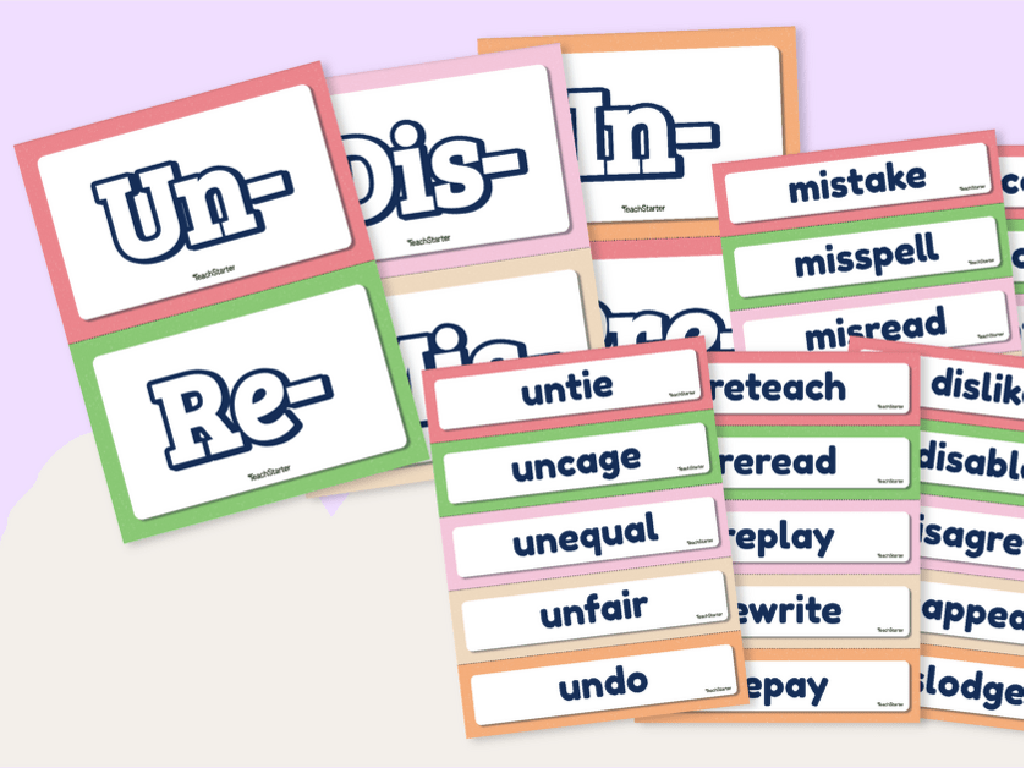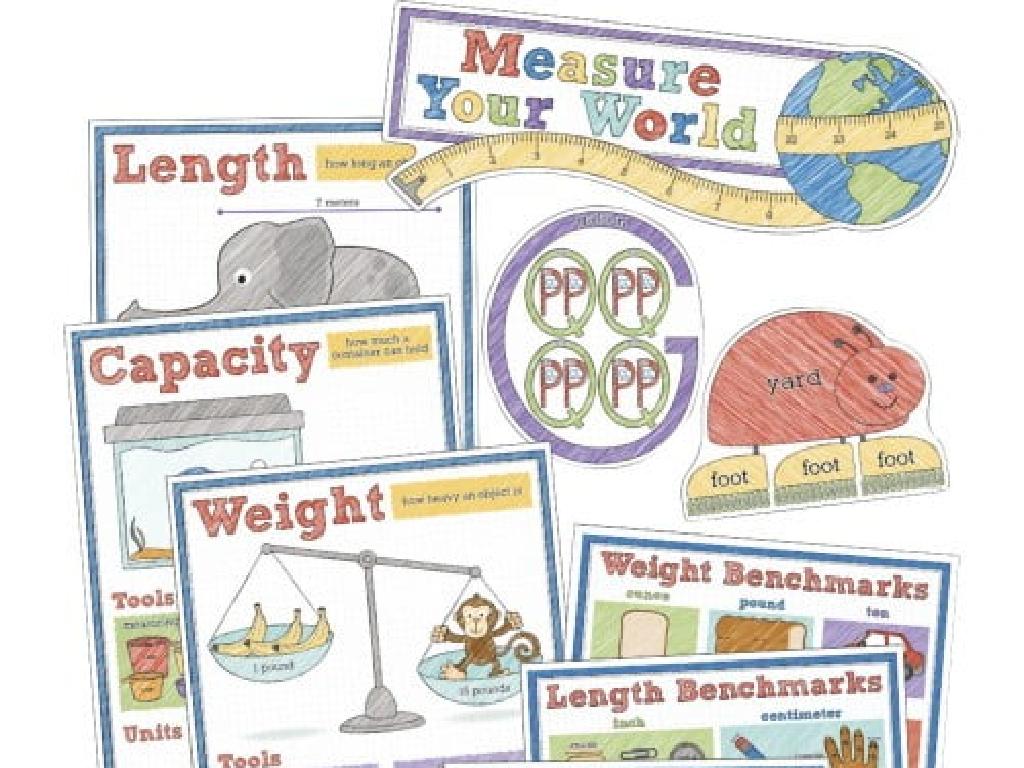Volume Of Cubes And Rectangular Prisms: Word Problems
Subject: Math
Grade: Sixth grade
Topic: Surface Area And Volume
Please LOG IN to download the presentation. Access is available to registered users only.
View More Content
Introduction to Volume: Exploring 3D Shapes
– Grasping 3D shapes concept
– Objects with length, width, height
– Defining volume
– Space inside a 3D object measured in cubic units
– Volume’s role in daily life
– Used in cooking, packing, filling pools
– Calculating volume practice
|
This slide introduces the concept of volume as it applies to three-dimensional shapes, which are characterized by having length, width, and height. Volume is defined as the amount of space inside a 3D object and is typically measured in cubic units. Understanding volume is crucial in everyday life for activities such as cooking (measuring ingredients), packing (knowing box capacity), or filling swimming pools (calculating water needed). The slide sets the stage for students to practice calculating the volume of various shapes, reinforcing their comprehension through real-world applications. Encourage students to think of other examples where they encounter volume in their daily lives.
Volume of a Cube: Mastering the Basics
– What is a cube?
– A cube is a 3D shape with equal sides and 90-degree angles.
– Volume formula: V = side^3
– To find volume, multiply the length of one side by itself three times.
– Example: Cube volume calculation
– If a cube’s side is 4 cm, volume is 4 cm x 4 cm x 4 cm = 64 cm^3.
– Practice with real-world problems
|
This slide introduces students to the concept of a cube and how to calculate its volume. Start by defining a cube, emphasizing its equal sides and right angles. Then, present the volume formula and ensure students understand that ‘side^3’ means multiplying the side length by itself twice more. Use a tangible example, such as a dice or a sugar cube, to illustrate. After explaining the formula, walk through a calculation example with the class. Finally, encourage students to apply this knowledge to solve real-world problems involving cube volumes, such as finding the amount of space inside a cubic box.
Volume of Rectangular Prisms
– Define a Rectangular Prism
– A 3D object with 6 faces, all rectangles
– Volume formula: V = l x w x h
– Example: Calculate a prism’s volume
– If a prism has dimensions 5cm x 3cm x 2cm, V = 5 x 3 x 2 = 30cm³
– Practice with real-world problems
– Apply formula to solve volume in scenarios like packing boxes
|
Introduce the concept of a rectangular prism by describing its properties, such as having six faces that are all rectangles. Explain the volume formula, emphasizing the multiplication of length, width, and height. Provide a clear example by calculating the volume of a prism with given dimensions. Encourage students to visualize real-world objects as rectangular prisms, such as a book or a shoebox, and use the formula to solve practical problems. For homework, assign a few word problems where they have to calculate the volume of items they might encounter in their daily lives.
Volume Word Problems: Cubes
– Read the problem carefully
– Understand what the problem asks for and the information given
– Identify known variables
– Look for the length of a cube’s side, which is needed to find volume
– Apply the cube volume formula
– Use the formula V = s^3, where V is volume and s is the side length
– Solve and check your answer
– Ensure the solution makes sense in the context of the problem
|
This slide is aimed at guiding students through the process of solving word problems involving the volume of cubes. Start by reading the problem thoroughly to understand what is being asked and what information is provided. Next, identify the known variables, which typically include the length of a side of the cube. Then, apply the volume formula for cubes (V = s^3) to find the solution. Encourage students to always double-check their answers to ensure accuracy and that their solution makes sense within the context of the problem. Provide examples of word problems and solve them together as a class, then assign similar problems for independent practice.
Volume Word Problems: Rectangular Prisms
– Read the problem carefully
– Find the known dimensions
– Look for length (l), width (w), and height (h)
– Use the volume formula V = lwh
– Remember, volume measures how much space is inside the prism
– Solve and check your answer
– Ensure your solution makes sense in the context of the problem
|
This slide is aimed at guiding students through the process of solving word problems involving the volume of rectangular prisms. Start by reading the problem thoroughly to understand what is being asked. Next, identify the known variables such as length, width, and height. Teach students the volume formula for rectangular prisms, V = lwh, where V is volume, l is length, w is width, and h is height. Emphasize the importance of units and converting them if necessary. Finally, encourage students to solve the problem and check their answers by considering if the result is logical within the context of the problem. Provide examples of word problems and solve them together as a class, then let students try on their own with guidance.
Group Activity: Solving Volume Problems
– Solve volume problems together
– Pair up for group activity
– Work with a partner to solve problems on volume of cubes and prisms
– Share solutions with the class
– Present how you solved the problem and your answer
– Discuss different methods used
– Talk about the strategies you and others used to find the volume
|
This slide is designed to facilitate a collaborative learning experience. Begin by solving a few volume problems as a class to demonstrate the process. Then, have the students pair up and work through a set of problems together, encouraging them to discuss their approaches and reasoning. After the activity, each pair will share their solutions and explain the methods they used to the rest of the class. This will help students learn from each other and understand different ways to tackle volume problems. As a teacher, circulate the room to offer guidance and ensure that each pair is on the right track. Possible activities could include finding the volume of everyday objects, creating their own word problems, or even building models to visualize the concept of volume.
Class Activity: Crafting Volume Word Problems
– Learn word problem components
– Create a volume scenario
– Imagine a situation like filling a pool or packing a box
– Swap problems with a peer
– Solve your classmate’s problem
– Apply formulas for volume to find solutions
|
This activity is designed to help students understand the structure of word problems and apply their knowledge of volume to real-life scenarios. Start by discussing the key components of a word problem, including the question, the data provided, and what is being asked to solve. Encourage students to think creatively and come up with a scenario where calculating the volume of a cube or rectangular prism is necessary, such as determining the amount of water needed to fill a swimming pool or the number of boxes that can fit in a storage space. After creating their problems, students will exchange them with a classmate and attempt to solve them, providing an opportunity for collaborative learning and application of volume formulas. Provide guidance on how to set up the equations for volume and ensure students understand how to find the length, width, and height from the context of the problem. Offer several examples of scenarios and word problems to inspire students.
Review: Volume of Cubes & Rectangular Prisms
– Recap key volume concepts
– Volume is measured in cubic units, like cm³
– Review solved word problems
– Look at examples we solved: find volume by multiplying length, width, height
– Engage in Q&A session
– Clarify any doubts
|
This slide aims to consolidate the students’ understanding of calculating the volume of cubes and rectangular prisms. Begin by revisiting the key concepts and formulas for volume calculation. Go over some of the word problems that have been solved in previous classes to reinforce the method of finding volume. Encourage students to ask questions about any part of the process they are unsure about. Use this opportunity to address common mistakes and clarify misconceptions. Provide additional examples if necessary to ensure all students are confident in solving volume word problems.
Homework: Volume Practice & Quiz Prep
– Solve practice volume problems
– Create an original volume word problem
– Think about everyday objects like a box or an aquarium
– Review volume concepts for quiz
– Focus on formulas for cubes and prisms
– Quiz next class on volume
|
This homework assignment is designed to reinforce the students’ understanding of volume calculation for cubes and rectangular prisms. Provide a set of practice problems that vary in difficulty to cater to all students. Encourage creativity in crafting an original word problem, perhaps drawing inspiration from real-life scenarios involving storage boxes, water tanks, or similar. Remind students to review the volume formulas: Volume of a cube (V = s^3) and Volume of a rectangular prism (V = lwh), where s is the side length, l is the length, w is the width, and h is the height. The upcoming quiz will assess their ability to apply these formulas and solve word problems. Offer additional resources or office hours for students who may need extra help preparing for the quiz.






